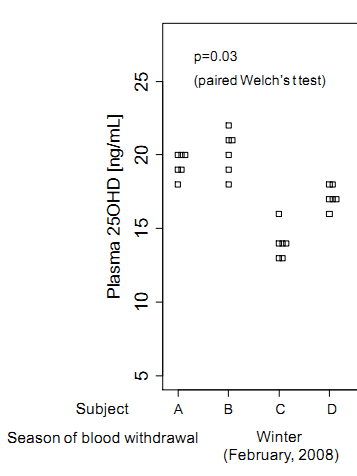Vitamin D measurements of individuals vary by 3 ng within 6 days
Vitamin D Deficiency and Seasonal and Inter-day Variation in Circulating 25-hydroxyvitamin D and Parathyroid Hormone Levels in Indoor Daytime Workers: A Longitudinal Study.
Ind Health. 2011 Jun 21.
Itoh H, Mori I, Matsumoto Y, Maki S, Ogawa Y.
National Institute of Occupational Safety and Health, Japan.
Seasonal variation in circulating 25-hydroxyvitamin D (25OHD) levels related to seasonal and inter-day fluctuation in sunlight ultraviolet irradiation, may lead to misjudgments concerning 25OHD status in individual workers around threshold levels. Here, to examine seasonal and inter-day variations in plasma 25OHD, we conducted a longitudinal study involving indoor daytime workers. Subjects were four male indoor daytime workers aged 32-57 yr working in Kawasaki City, Japan.
Blood samples were obtained on six days within two two-week periods in February and October, 2008. Plasma 25OHD, serum intact parathyroid hormone (PTH) and 1?,25-dihydroxyvitamin D [1?,25(OH)(2)D] were measured. Individual monthly mean 25OHD levels were 16-56% higher in October than in February (p=0.03), while individual monthly mean intact PTH levels were 15-41% lower in October (p=0.09). No seasonal change was observed in 1?,25(OH)(2)D (p=0.62). Notably, nearly all measured 25OHD levels in February were lower than the reference value of 20 ng/ml. Our study identified the occurrence of seasonal variation in circulating 25OHD and intact PTH levels, even after accounting for inter-day variability, and hypovitaminosis D in wintertime in indoor daytime male workers in Japan. Due to this variability, single spot measurements of 25OHD may lead to misjudgment of workers' vitamin D status.
PMID: 21697621
Study is attached at the bottom on this page
Individuals A, B, C, D

See also Vitamin D Life
Vitamin D blood testing within plus or minus 7 percent – Mar 2010 variation between labs
Comparison of vitamin D blood tests – worse case off by 15% – Aug 2010 variation between labs
